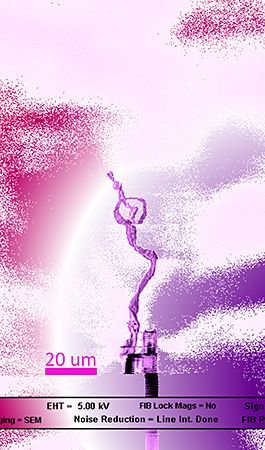Jun 22 2009
Imagine how passionately this 0.00007 metre short musician blows his instrument toward the sky at dawn to make sound volume with his tiny breast. His full height is about the diameter of a thick hair. The diameter of the trumpet tube is around about 0.0000001 metre (100 nanometres) and its length about 0.00001 metre (10 micrometres). This contender for the world's smallest standing statue of a musician has been fabricated as a part of a Nanotechnology MSc student project at the London Centre for Nanotechnology (LCN).
 Almost certainly the world's smallest Trumpeter
Almost certainly the world's smallest Trumpeter
“This sculpture happened to appear during advanced silicon etching (ASE®) with high-tech “plasma” process in a vacuum chamber. Therefore, his “chamber” music could not be transmitted physically via vacuum outside his room, unfortunately,” says project supervisor, Dr Takashi Matsuura.
This student project aimed at both nanofabrication of three-dimensional artificial structures with plasma technologies and their engineering applications. The project's objective isthe demonstration of nanostructure fabrication capability over a few tens centimetre wide area - this is quite challenging as the dimensional dynamic range spreads over millions. Refining the nanofabrication process further by incorporating artistic sensibilities would draw wider public interest in nanotechnologies.
In addition to the diminutive musician, “a frosty glass for a pint of beer” and “Seabed creatures” have been created by a former MSc student Mr Henry Crawford during his experiments on plasma process optimisation. Although colorful and complex images are widely spread in the recent Nanoart world, this type of simple and monochromatic three-dimensional (3D) sculptures are more reminiscent of classical sculpture and artwork.
“These kinds of novel 3D nanostructures are very interesting. The project also involves the study of the basic reaction mechanisms occurring at the atomic scale in the reaction schemes. It may also be possible to apply the fabricated structures to prototype test devices and to new device idea,” says co-supervisor Prof. Ian Boyd.
Plasma is gas excited by radio frequency electric power into a complex mixture of ionized atoms and molecules as well as electrons and neutral radicals. A familiar example of plasma is one generated inside a fluorescent tube when it is turned on. More sophisticated plasma with particular reactive gases can conduct this type of fabrication in a carefully-designed vacuum chamber within state-of-the-art instruments.
Plasma processing is currently the favoured tool for fabricating three-dimensional nanostructures in planar technology, such as silicon integrated circuit technology, enabling the possibility of fabricating a wide variety of novel electronic, medical and MEMS devices. The plasma approach has the dual advantage of inducing directional chemical reactions due to linear acceleration of the ions produced by the bias voltage, and of lowering reaction temperatures due to the plasma-generated reactive species.
“Some may find humor in this news as 'blowing your own trumpet 'in English slang may mean exaggerating, but I hope this report is received with general acceptance,” adds Dr Takashi Matsuura.